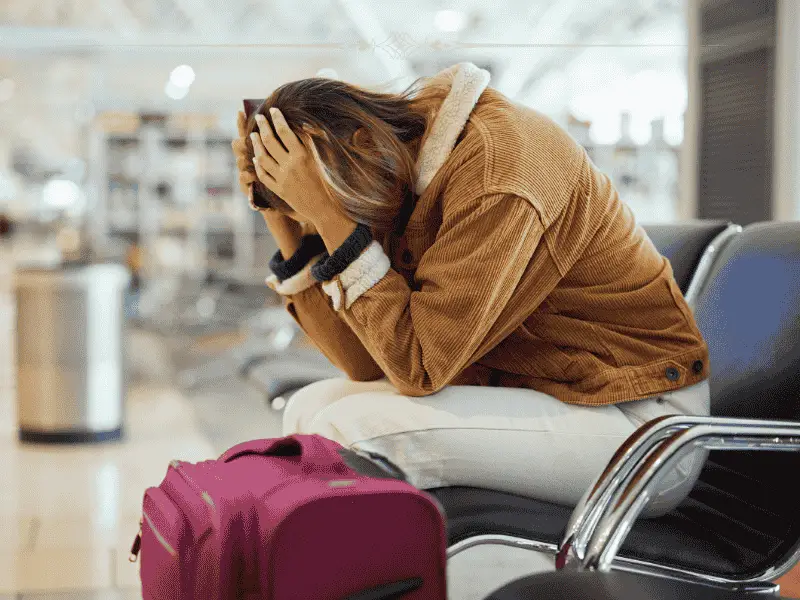A controversial social media trend is causing chaos at airports nationwide as travelers miss their flights in record numbers. The so-called “Airport Theory,” which has exploded across TikTok in recent months, encourages passengers to arrive just 15 minutes before their scheduled departures—directly contradicting long-established travel protocols and leaving many stranded at terminals.

The Rise of “Just-in-Time” Travel
The conventional wisdom of arriving hours ahead of your flight’s departure time is being challenged by a growing number of content creators on TikTok. These influencers advocate for what they call the “Airport Theory”—a strategy that suggests passengers can safely arrive at the airport a mere 15 minutes before their flight and still make it on board without issue.
This trend has captured the imagination of millions of viewers, amassing over 400 million views on the platform. It presents an alluring proposition: eliminate the tedious waiting time at airports by precisely timing your arrival to coincide with the final boarding call.
The appeal is understandable. Instead of spending hours in uncomfortable airport seating areas or overpriced terminal restaurants, proponents of the theory suggest you can maximize your time elsewhere and still catch your flight. For busy travelers or those who detest the sterile environment of airport terminals, this approach seems to offer the ultimate hack.
However, as the trend continues to gain traction, a concerning pattern has emerged. What started as an appealing time-saving strategy has evolved into a high-stakes gamble that’s leaving many travelers stranded, frustrated, and facing significant additional expenses.
The Mechanics of the Movement
The Airport Theory operates on a simple premise: traditional arrival recommendations are unnecessarily cautious and waste travelers’ valuable time. Instead of arriving the standard two hours before domestic flights or three hours for international journeys, adherents to this theory suggest that 15 minutes is sufficient time to navigate check-in procedures, security screening, and reach your departure gate.
Proponents point to technological advancements like online check-in, digital boarding passes, and expedited security options as justification for this dramatically reduced arrival window. They argue that airports have become more efficient, and therefore, the traditional buffer time is an outdated concept that can be safely disregarded.
The theory has gained particular popularity among younger travelers who value efficiency and are comfortable navigating the technological shortcuts of modern air travel. For these digital natives, the idea of minimizing “wasted” time at airports resonates with their on-demand lifestyle expectations.
Content creators documenting their successful last-minute arrivals provide apparent validation of the theory. Their videos follow a familiar format: a rushed entrance to the airport, hurried progression through security, and a triumphant arrival at the gate just as boarding begins. These videos, often set to upbeat music and featuring relieved celebrations, make the approach seem not only feasible but exhilarating.
Success Stories Fuel the Fire
The trend has gathered momentum through highly-watched success stories. Various content creators have documented their experiences attempting the 15-minute airport arrival, with some managing to board their flights successfully—further encouraging others to try the same approach.
One such video creator captured her experience arriving at the airport with barely any time to spare. Despite being randomly selected for additional security screening, she claimed to navigate from the airport entrance to her departure gate in just 15 minutes. According to her video, she was even the first passenger to board the aircraft despite her late arrival.
These success stories present a compelling narrative: that traditional airport timing recommendations are overly cautious and unnecessary in today’s streamlined travel environment. For viewers watching these seemingly effortless last-minute boardings, the theory appears not just plausible but preferable to conventional approaches.
The videos rarely emphasize the specific circumstances that made such tight timing possible—factors like traveling during off-peak hours, flying from smaller regional airports with minimal security lines, not checking baggage, or benefiting from premium traveler status that allows access to expedited services.
When Theory Meets Reality
Despite the enticing portrayal of Airport Theory in viral videos, the reality for many who attempt this approach has proven far less glamorous. As the trend has gained popularity, so too have the number of cautionary tales from travelers who tested the theory only to find themselves watching their aircraft depart without them.
One particularly viral failure documented a traveler confidently walking toward her gate with an iced coffee in hand, only to discover that boarding had concluded and her American Airlines flight had already closed its doors. Her video, which has garnered nearly 16 million views, now serves as a warning to others contemplating the same approach.
The aftermath of missed flights extends far beyond the initial disappointment. Travelers often face substantial rebooking fees, the cost of overnight accommodations if alternative flights aren’t immediately available, and the cascading impact on subsequent travel arrangements, including hotel reservations and planned activities at their destination.
For business travelers, missed meetings and appointments can result in professional consequences far exceeding the time “saved” by attempting a last-minute arrival. For leisure travelers, lost vacation days represent irretrievable personal time that no refund can truly compensate.
The Statistical Surge
The real-world impact of this trend is becoming increasingly measurable. Travel website Netflights has reported a staggering 645% increase in Google searches for “I missed my flight” over the past month alone—a statistical correlation that experts attribute directly to the rising popularity of the Airport Theory trend.
This dramatic surge in missed flight inquiries suggests that what appears to be a harmless social media challenge is translating into tangible travel disruptions for a significant number of people. The data indicates that for every successful last-minute boarding documented on TikTok, many more travelers are likely experiencing the opposite outcome.
Travel industry analysts point out that this trend couldn’t have emerged at a worse time for the aviation industry. With airports and airlines still recovering from post-pandemic staffing shortages and adjusting to fluctuating travel volumes, the system has less flexibility to accommodate passengers who cut timing too close.
The Expert Assessment
Travel professionals have been quick to identify the flaws in the Airport Theory’s fundamental premise. According to Amanda Parker, a travel expert at Netflights, the trend’s viability “largely depends on variable factors like queue times and the distance to your gate, which can differ depending on the airport and time of your flight.”
Parker highlights a critical discrepancy in the theory’s timing: “Boarding typically begins 45 minutes before departure, which is half an hour earlier than the 15 minutes suggested in ‘Airport Theory,’ further emphasizing the risks of following this trend.”
Aviation industry professionals emphasize that airport operations are designed around anticipated passenger flow rates. The recommended arrival times—generally two hours for domestic flights and three hours for international departures—are not arbitrary numbers but calculated guidelines based on processing capacities and potential variables.
Security screening procedures, in particular, represent an unpredictable variable in the airport experience. Random selection for additional screening, as demonstrated in one of the viral videos, can add significant time to the process—time that the Airport Theory doesn’t account for in its tight scheduling.
The Variables That Make or Break
The Airport Theory functions on the assumption of ideal conditions—a dangerous premise in the complex ecosystem of commercial aviation. Numerous variables can extend transit time through an airport, many of which are entirely outside a traveler’s control.
Security screening wait times fluctuate dramatically based on the time of day, day of the week, and seasonal travel patterns. During holiday periods or peak travel seasons, security lines that might take five minutes to navigate during quieter periods can extend to 45 minutes or longer.
Terminal layout represents another significant variable. While some airports feature centralized security checkpoints with gates in close proximity, others require passengers to navigate extensive distances between checkpoints and gates, sometimes necessitating shuttle transportation between terminals.
Check-in requirements vary by airline and destination. International flights often require document verification that cannot be completed through self-service kiosks or mobile applications. Similarly, checked baggage procedures add an additional layer of processing time unaccounted for in the 15-minute model.
Uncontrollable Factors
Beyond the predictable variables of airport operations, truly unpredictable factors can derail even the most carefully timed airport arrival. Traffic congestion en route to the airport, parking availability, public transportation delays, and weather conditions all introduce elements of uncertainty that the Airport Theory fails to adequately address.
Airport operational changes occur with minimal notice. Gate reassignments, security lane closures, or equipment malfunctions can dramatically alter the time required to reach your departure point. In these scenarios, the minimal buffer provided by a 15-minute arrival window leaves virtually no margin for adaptation.
Staff shortages have become increasingly common in the post-pandemic travel landscape. Reduced personnel at check-in counters, security checkpoints, and boarding gates can significantly extend processing times even during what would historically be considered non-peak periods.
Weather events, both at the departure airport and elsewhere in the national aviation network, can trigger cascading delays that affect security processing times as flights are rescheduled and passenger volumes shift unpredictably.
The Psychological Cost
Beyond the practical implications of missed flights and additional expenses, travel experts highlight the psychological impact of cutting airport timing so close. The stress associated with rushing through an airport, constantly checking the time, and worrying about making your flight introduces an emotional toll that undermines the supposed benefits of the Airport Theory.
For many travelers, the anxiety generated by such a tight timeline negates any potential advantages of spending less time at the airport. This sentiment is reflected in comments on the viral videos, with many viewers expressing that their anxiety levels would never permit them to attempt such a risky approach to air travel.
Mental health professionals note that beginning a journey in a state of elevated stress can negatively impact the overall travel experience. The physiological stress response triggered by rushing and uncertainty can linger for hours after reaching your destination, potentially affecting the quality of your trip.
The Economic Equation
From a purely economic perspective, the Airport Theory presents a deeply flawed value proposition. The potential time saved by arriving later must be weighed against the financial risk of missing a flight—a calculation that rarely favors the minimalist approach.
Missed flight policies vary by airline and fare class, but most carriers charge substantial fees for same-day rebooking, often equivalent to or exceeding the original ticket price. For non-refundable fares, missing a flight can result in a complete loss of the ticket value.
Additional accommodation costs frequently accompany missed flights, particularly for travelers who cannot be accommodated on alternative flights the same day. These unexpected expenses, combined with meals and transportation costs, can quickly escalate into hundreds or thousands of dollars.
Time valuation represents perhaps the most significant economic factor. Even if successful, the Airport Theory typically saves travelers one to two hours of waiting time. When balanced against the potential loss of vacation days or business opportunities if a flight is missed, this minimal time saving rarely justifies the associated risk.
Airline Industry Response
As the Airport Theory trend continues to spread across social media platforms, airlines and airport authorities have begun responding to the phenomenon. Several major carriers have issued statements reminding passengers of the importance of adhering to recommended arrival times.
Some airlines have even updated their pre-flight communication to specifically address the trend, emphasizing that boarding gates close promptly before departure and that passengers arriving after these cutoff times will not be accommodated regardless of their reasons for late arrival.
Airport authorities have similarly reinforced their timing recommendations, with some launching educational campaigns highlighting the various processing stages that necessitate earlier arrival. These communications typically emphasize that the recommended arrival windows are designed to accommodate average processing times plus contingency for unexpected delays.
Industry representatives express concern that the trend not only impacts individual travelers who miss their flights but also creates operational inefficiencies. Last-minute passenger arrivals can delay departure procedures as gate agents attempt to reconcile passenger manifests, potentially causing cascade effects throughout the air traffic system.
The Broader Trend Context
The Airport Theory exists within a broader social media landscape of “life hack” content that promises to optimize everyday experiences. Travel experts note that this particular trend exemplifies the potential dangers of applying oversimplified solutions to complex systems like commercial aviation.
Digital media researchers observe that the format of short-form video platforms like TikTok inherently favors content that presents dramatic outcomes—either spectacular successes or catastrophic failures. This content ecosystem rewards extreme approaches over more measured, reasonable strategies.
The viral spread of the Airport Theory also highlights the influence of social media on travel behaviors, particularly among younger demographics. Travel industry analysts have noted an increasing tendency for travelers to make decisions based on content consumed through social platforms rather than official guidance from airlines or airports.
Finding Middle Ground
Despite the clear risks associated with the Airport Theory’s extreme approach, travel experts suggest there may be some valuable takeaways from questioning traditional arrival time recommendations. While the 15-minute window is universally recognized as dangerously insufficient, there may be circumstances where the full two or three-hour buffer is unnecessary.
Frequent travelers with trusted traveler status, no checked baggage, and familiarity with specific airports may reasonably adjust their arrival times based on experience and current conditions. Mobile apps providing real-time updates on security wait times can help inform more calibrated arrival planning.
The conversation sparked by the trend has prompted some useful discussions about efficiency improvements in airport processing. Innovations in biometric verification, advanced security screening technology, and digital documentation verification continue to streamline the pre-flight experience.
Travel professionals suggest focusing on stress reduction rather than time minimization as a more valuable approach to airport experiences. Arriving with sufficient buffer time allows travelers to navigate the process calmly, potentially enhancing the overall journey rather than beginning it with unnecessary anxiety.
As the Airport Theory trend eventually fades—likely replaced by the next viral travel challenge—its impact on passenger behaviors and aviation industry practices may linger. The conversation about appropriate arrival timing continues to evolve alongside technological advancements in airport processing.
Advanced predictive analytics now enable some airports to provide more personalized arrival recommendations based on specific flight times, security processing volumes, and terminal configurations. These data-driven approaches offer more nuanced guidance than the one-size-fits-all recommendations of the past.
Continued investment in expedited security programs, automated check-in processes, and digital identity verification promises to further streamline the pre-flight experience. However, industry experts emphasize that these improvements aim to make the process more pleasant rather than dramatically shorter.
The most enduring lesson from the Airport Theory phenomenon may be the reminder that air travel remains a complex system with numerous interdependent variables. Despite technological advances, the fundamental advice remains unchanged: build in appropriate buffer time for a less stressful, more reliable travel experience.
In the eternal tension between efficiency and reliability, the Airport Theory represents an extreme prioritization of the former at the expense of the latter. As travelers everywhere continue to share their experiences—both the rare successes and the more common failures—the collective wisdom seems clear: those extra minutes at the gate are a small price to pay for travel peace of mind.




